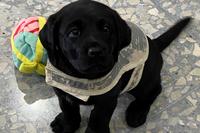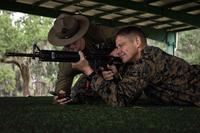The Predator, the General Atomics unmanned aerial vehicle pulling surveillance and combat duties over Iraq and Afghanistan, was a no-show at the Paris Air Show this week. Not even a mock-up of the spy-cum-killer drone to be seen among the displays of aircraft.
In contrast, a Global Hawk display was set up by the Northrop Grumman building at the show and company officials made pitch after pitch on the drone's capabilities.
But other UAVs – including an incredibly short helicopter that can fly with or without a pilot -- were on display, further evidence of the emerging role of drones in war and security.
Selex Galileo, a Finmeccanica company, had several mock-ups displayed at the air show, including the Falco, a tactical, medium-altitude UAV touted for surveillance use. It can be loaded up with different payloads, including electro-optical/infrared systems, surveillance approach and maritime surveillance radars, and nuclear, biological and chemical sensors, depending on the user’s needs, according to the company.
One of the oddest looking drones on display, though, was a helicopter whose fuselage was not much bigger than a 1960s’ model Volkswagen Beetle – if that! – and with a propeller in the rear for additional forward thrust. The Xenon, based on the now rarely seen gyrocopter, was acquired from Celia Aviation of Poland for use by Selex Galileo as a Short Take-Off and Landing, Optionally Piloted Vehicle. Yep, it’ll fly with or without a human at the controls. But as a third option, it can be manned by a pilot but with surveillance or other payload controlled by a ground station.
One of the oddest looking drones on display, though, was a helicopter whose fuselage was not much bigger than a 1960s’ model Volkswagen Beetle – if that! – and with a propeller in the rear for additional forward thrust. The Xenon, based on the now rarely seen gyrocopter, was acquired from Celia Aviation of Poland for use by Selex Galileo as a Short Take-Off and Landing Optionally Piloted Vehicle.
At the air show, the belly of the miniature helo was outfitted with Selex Galileo’s EPTAVIEW sensor pod, which provides the pilot -- or ground station controller -- with 360 degrees of sensor coverage.
But the smallest robot vehicle in the lot does not even have wings. It’s a guard-bot that, in the display version, touts a machine gun and two grenade launchers. The TRP2 – Teleoperated Robotic Platform – is a small, treaded vehicle that comes with a set of “towers” – one geared for surveillance only, the other for combat, said Jacobo Pellini, a technician assigned to the display.
Even with its weapons tower, it has four cameras – two dedicated to the guns and two for surveillance, of which one is infrared, he said.
A display of the largest and most deadly UAV is set up by the Lockheed chalet at the air show, though it is not – at least not yet – being advertised as a drone. This is the F-35 Joint Strike Fighter, which some Air Force leaders and even Lockheed has said could be converted to fly without a pilot. Several years ago a former Air Force chief of staff predicted that the last group or block of JSF’s planned for production would be drones.
If that doesn’t show the direction warfighters are headed, then news this week from the Air Force should. According to the Air Force, it will train 214 fighter and bomber pilots by the end of the fiscal year. Also by that time, it will have trained 240 UAV pilots.







